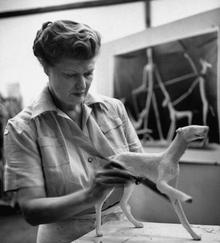Mary Callery
| Mary Callery | |
|---|---|

Callery in 1952
|
|
| Born |
June 19, 1903 New York City, USA |
| Died | February 12, 1977 Paris, France |
| Nationality | American |
| Known for | Sculpture |
| Movement | Abstract expressionism; American Figurative Expressionism |
Mary Callery (1903 – 1977) was an American artist known for her Modern and Abstract Expressionist sculpture. She was part of the New York School art movement of the 1940s, 1950s and 1960s.
It is said she "wove linear figures of acrobats and dancers, as slim as spaghetti and as flexible as India rubber, into openwork bronze and steel forms. A friend of Picasso, she was one of those who brought the good word of French modernism to America at the start of World War II".
Mary Callery was born and studied in New York City. Callery studied at the Art Student’s League from 1921–25 and moved to Paris in 1930. While in Paris, Callery began collecting the art of her peers: Picasso, Duchamps, Matisse. Callery returned to New York City at the outbreak of WWII and played an instrumental role in the development and growth of ULAE (Universal Limited Art Editions, Inc.). For many years, ULAE primarily published reproductions. It is thought by many the Mary Callery was the first artist to print original work at ULAE. Callery’s first edition with ULAE, Sons of Morning, was completed in 1955. The paper that Callery’s second edition, Variations on a Theme of “Callery-Léger”, was printed on was called the “Callery gray” was used by Mrs. Grosman for the studio’s first printed labels, and is still the trademark gray ULAE uses today.
From 1930 to 1940, Callery worked in France, where she met and became friends with Pablo Picasso,Henri Matisse, Fernand Léger, Alexander Calder, Aristide Maillol, and other leading artists of the day and collected their art. During this same period, she also developed her talents as a modern sculptor. When Germany occupied Paris during World War II, she returned to the United States with "more Picassos than anyone in America" according to Alfred Barr of the Museum of Modern Art. Architect Philip Johnson, whom she had met her in Paris, became a close friend, and he introduced her to major players in the world of business and art in New York, including Nelson and Abby Rockefeller. Wallace Harrison, who along with Johnson, was responsible for the design of Lincoln Center, commissioned Callery to create a sculpture for the top of the proscenium arch at the Metropolitan Opera House. Described as "an untitled ensemble of bronze forms creating a bouquet of sculptured arabesques," it is perhaps her best known work. It is most affectionately known by The Metropolitan Opera Company members as "The Car Wreck"and more infrequently as "Spaghetti Spoon in Congress with Plumbers Strap". She was represented by the prestigious art dealers M. Knoedler & Co. and the Curt Valentin Gallery, and she exhibited in more than twenty noteworthy solo and group exhibitions. She became an acquaintance of Georgia O'Keeffe and in 1945 made a sculpture of O'Keeffe's head. Callery returned to France regularly throughout her career, and she died on February 12, 1977 at the American Hospital of Paris. She is buried in Cadaqués, Spain.
...
Wikipedia
